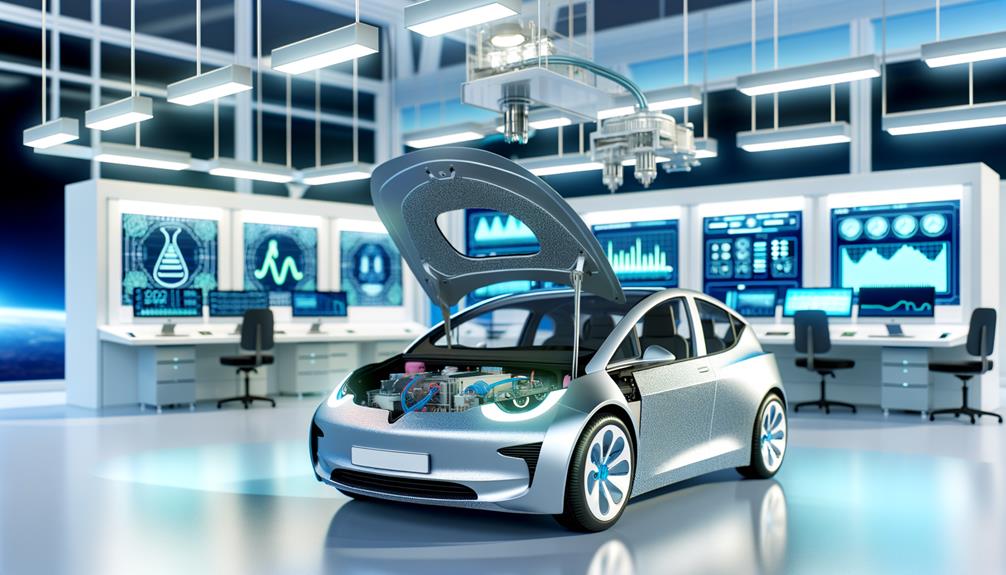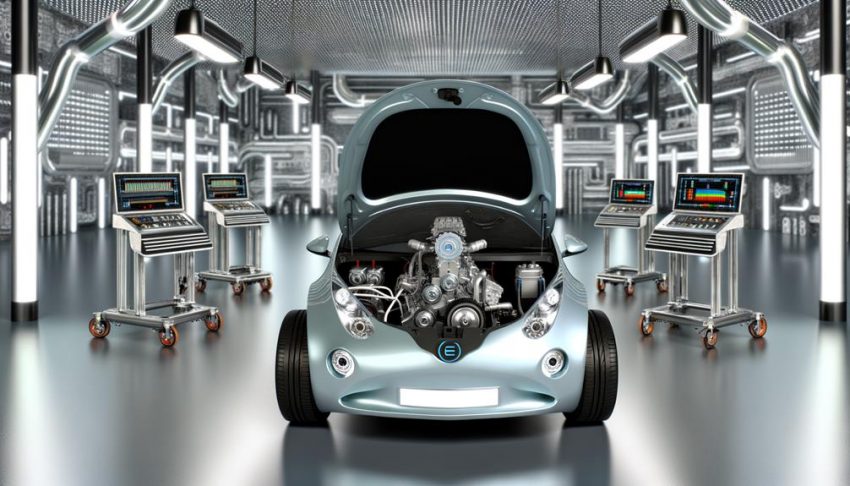You might be wondering if electric cars have alternators like traditional vehicles. While it's a common assumption, electric cars actually operate quite differently. Instead of using alternators to convert mechanical energy to electrical energy, EVs rely on high-voltage batteries and sophisticated DC/DC converters to manage their energy needs. This distinction raises some intriguing questions about the functionality and efficiency of electric vehicles. So, how do these differences impact the overall performance and maintenance of EVs? Let's explore this fascinating aspect of automotive technology.
Contents
What Is an Alternator?
An alternator, converting mechanical energy from an internal combustion engine into electrical energy, is an essential component in gasoline-powered vehicles. This device guarantees your vehicle's battery stays charged and powers all electrical systems, including lights, radio, and other accessories.
When the engine runs, it drives the alternator via a belt. The alternator's rotor spins within a magnetic field, generating Alternating Current (AC). This AC is then converted to Direct Current (DC) by diodes within the alternator. The resultant DC is what charges the vehicle's battery and powers the electrical systems. Typically, the output voltage of an automotive alternator is around 12 volts, which is adequate for most vehicle accessories and for maintaining the battery's charge.
However, the process is not without its inefficiencies. The conversion of mechanical energy to electrical energy involves energy losses. Additionally, the alternator requires mechanical input from the engine, which itself consumes fuel and generates heat. Therefore, the overall efficiency of the alternator is inherently limited by these factors.
Another significant point is that alternators only function when the engine is running. This means if your engine is off, the alternator can't generate electrical energy, and the vehicle relies solely on the stored power in the battery. This is why the alternator's proper functioning is essential for the longevity of your vehicle's battery and the consistent operation of its electrical systems.
Energy Needs of EVs
Electric vehicles (EVs) rely on electricity stored in substantial battery packs, charged from external power sources rather than depending on an alternator. These battery packs are the crux of an EV's energy system, providing the necessary power to drive the electric motor and operate various onboard systems. Unlike internal combustion engine vehicles, which use alternators to recharge the battery while driving, EVs utilize external charging methods, such as Level 2 chargers or DC Fast Charging, to replenish their battery packs.
A critical component in EVs is the DC/DC converter, which efficiently steps down the high-voltage output from the battery pack to a standard 12-volt supply needed for auxiliary systems like lighting and infotainment. This converter eliminates the need for an alternator, optimizing energy management and contributing to overall vehicle efficiency. Consequently, the absence of an alternator in EVs not only reduces mechanical complexity but also improves battery longevity by avoiding the constant drain associated with traditional alternators.
Regenerative braking plays a pivotal role in the energy needs of EVs. This technology captures kinetic energy during deceleration and converts it back into electrical energy, which is then fed back into the battery pack. By recuperating energy that would otherwise be lost as heat, regenerative braking considerably boosts the overall energy efficiency of the vehicle. This system guarantees that EVs maximize the utility of their stored energy, minimizing the frequency and duration of charging sessions.
Why EVs Don't Use Alternators

One of the primary reasons EVs don't use alternators is due to their reliance on high-voltage battery systems for energy, unlike traditional alternators that convert mechanical energy from an internal combustion engine into electricity. In an EV, the high-voltage battery system is the heart of the vehicle's power supply, eliminating the need for an alternator to generate electricity.
Installing an alternator in an EV would result in a net energy loss. Alternators are designed to work with internal combustion engines, converting mechanical energy from the engine into electrical energy to recharge the battery. However, in the absence of a running engine, an alternator in an EV would consume more power than it produces, thereby reducing overall energy efficiency.
Instead, EVs utilize DC/DC converters to efficiently convert the high-voltage battery output to 12 volts, which is necessary for powering accessories like lights, infotainment systems, and other electronic components. This approach is far more efficient than using an alternator, as it directly taps into the existing battery system without the need for another energy conversion step.
Moreover, EVs recharge their batteries through external charging stations and regenerative braking systems, which capture and convert the kinetic energy generated during deceleration back into electrical energy. This method not only recharges the battery but also enhances the vehicle's overall energy efficiency and battery longevity.
Alternatives to Alternators in EVs
Given that EVs don't use alternators due to the inefficiencies of converting mechanical energy from an engine that doesn't exist, it's important to examine the alternatives that have been implemented to achieve the same goal of powering vehicle accessories and recharging batteries. Instead of an alternator, EVs utilize multiple advanced technologies designed to enhance energy efficiency and reliability.
- DC/DC Converter: The DC/DC converter is essential in EVs. It converts the high-voltage output from the main battery pack to the standard 12-volt level required to power accessories like lights, infotainment systems, and power windows. Unlike an alternator, it efficiently manages the energy requirements without mechanical losses.
- Regenerative Braking: Regenerative braking is a standout feature in EVs, capturing kinetic energy during deceleration and converting it back into electrical energy. This energy is then used to recharge the battery. The alternator is always dependent on mechanical rotation, but regenerative braking makes efficient use of the vehicle's motion to recover energy.
- Battery Management Systems (BMS): Advanced BMS in EVs guarantee ideal energy distribution and monitor battery health. They play a pivotal role in maintaining battery efficiency and longevity, functions that an alternator is always unable to perform due to its mechanical nature.
- Renewable Energy Integration: Some EVs incorporate renewable energy sources like solar panels. These panels can supplement power and help recharge the batteries, further reducing the dependency on traditional mechanical systems such as alternators.
Future of EV Technology

As we look towards the future of EV technology, considerable advancements are on the horizon, particularly with the development of solid-state batteries. These batteries promise higher energy density and faster charging times compared to current lithium-ion batteries, revolutionizing how Electric Vehicles (EVs) are powered and maintained. With higher energy density, you'll see EVs traveling longer distances on a single charge, making them more practical for everyday use.
Innovations in battery recycling methods are essential for sustainable EV growth. By focusing on minimizing environmental impact and maximizing resource recovery, the industry aims to address the ecological concerns associated with battery disposal. Advanced power electronics and battery management systems are also being integrated into next-generation EVs. These technologies will enhance energy efficiency and vehicle performance, ensuring that your battery stays charged longer and operates more efficiently.
Emerging charging infrastructure is another critical area of development. Ultra-fast charging stations are being developed to support the increasing demand for EVs. These stations aim to reduce charging times to mere minutes, greatly improving the convenience of owning an EV. Imagine stopping at a charging station and having your EV ready to go in the time it takes to grab a coffee.
Government regulations and incentives are playing a pivotal role in driving the shift to electric mobility. These policies encourage manufacturers to invest in cleaner technologies and innovative designs for future EV models. As a result, you can expect a broader range of efficient, high-performing EVs entering the market, making the transition to electric transportation smoother and more appealing.
Frequently Asked Questions
Why Are There No Alternators on Electric Cars?
There are no alternators on electric cars because battery technology and energy efficiency are optimized without them. Regenerative braking and DC/DC converters manage power needs, making alternators redundant and less efficient for electric vehicle operation.
Why Can't Electric Cars Charge Themselves While Driving?
Electric cars can't charge themselves while driving due to battery efficiency limits and power management constraints. Regenerative braking helps recover some energy, but it doesn't generate extra power, consequently requiring external charging sources for battery replenishment.
Can an Electric Car Be Charged by an Alternator?
You can't charge an electric car with an alternator because it decreases charging efficiency and causes unnecessary energy conversion losses. Regenerative braking is a more effective method, capturing kinetic energy and converting it back into electrical energy.
Why Don't Electric Cars Have a Generator?
Electric cars don't have generators because they rely on high-capacity batteries and regenerative braking for energy efficiency. Using a generator would compromise battery maintenance by causing energy losses, making it less efficient.
Conclusion
In conclusion, electric cars don't use alternators due to their reliance on high-voltage battery systems and DC/DC converters for managing electrical needs. Regenerative braking further enhances energy efficiency by recapturing kinetic energy. These technologies eliminate the need for mechanical energy conversion and associated complexities. As EV technology continues to advance, we can expect further innovations that optimize energy management and efficiency, making traditional alternators obsolete in the context of electric vehicles.
